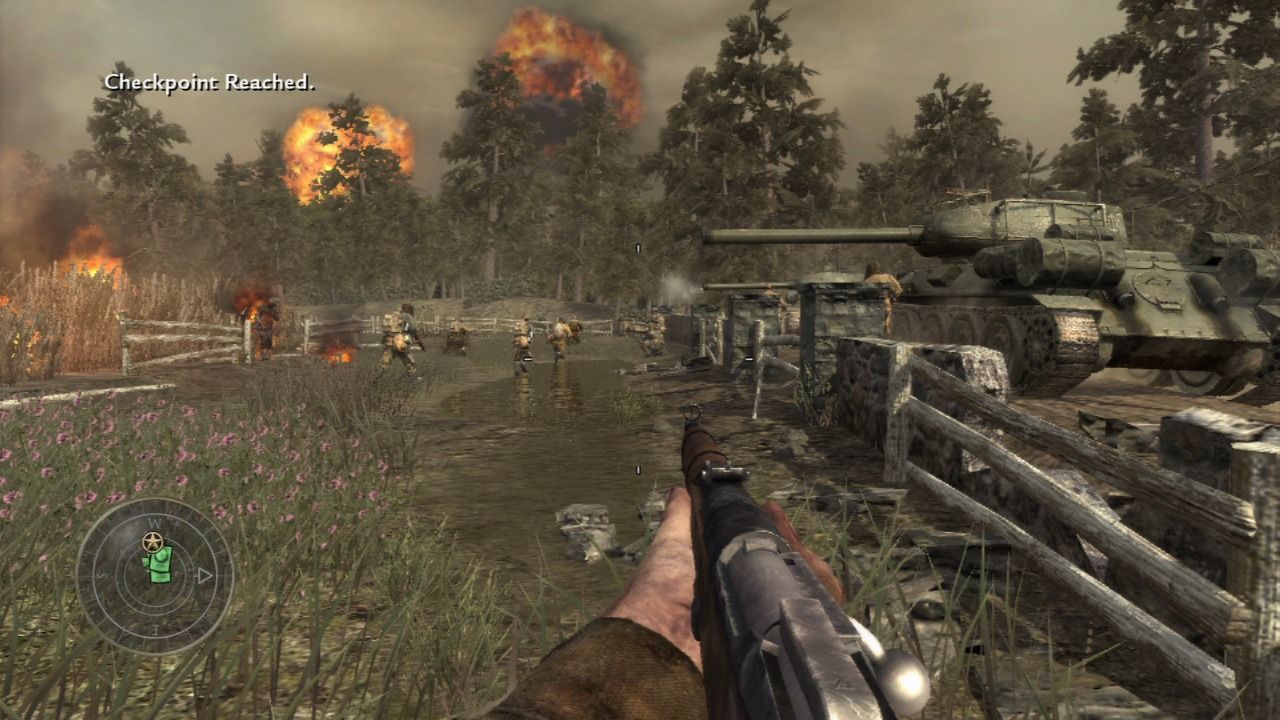
Every year for the past 3 years, the holiday season has meant a new next-generation Call of Duty game. Up until last year, every entry in the series has been a World War II-based shooter. Last year’s Call of Duty 4: Modern Warfare, however, brought the series into the present day and, thanks to a new graphics engine and a spectacular multiplayer mode, it was met with thunderous praise from gamers everywhere. So when Activision announced Call of Duty: World at War would return to the World War II format, there was some disappointment echoing across gaming forums and chatrooms around the globe. The question was: “Why take a step backwards?” To its credit, Call of Duty: World at War does try some new things with the World War II scenario as well as making some advances in the realistic portrayal of combat.
Those who’ve played through the previous Xbox 360 entries in the series will have no trouble getting things done in this outing. The controls are unchanged from Call of Duty 4. In fact, the game skips any kind of training or orientation and throws the player directly into the action. That being said, one might wonder why this game is even necessary since so little has changed.
One of the first things that stands out is that, for the first time in the series, the action takes place in the Pacific theater as well as the European theater of the war. As the game kicks off, the player finds himself in the role of Private Miller, an American soldier who has been captured by the Japanese. Just before he is about to be executed, Miller is saved by a small team of American soldiers with whom he joins in combat to begin the game’s first mission. Then, things move to the Eastern front of the European theater, as the player takes on the role of Private Petrenko, a Russian soldier who narrowly escapes death at the hands of the Germans at the beginning of his first mission.
The grisly reality of combat is evident in every mission. Enemy soldiers (as well as the A.I.-controlled allied troops) can be dismembered by explosions and gunfire. In fact, it’s not unusual to find appendages scattered across the battlefield as you look for your next objective or the next bit of ammunition. Soldiers also spray copious amounts of blood when they’re shot or meet their fate as the result of a well-thrown grenade. This added realism is at once shocking and a reminder that real war is not a game. 60 million people died in World War II, the game reminds us just before the end credits roll. Call of Duty: World at War isn’t as nauseatingly gruesome a reminder as, say, the opening scene of Saving Private Ryan, but it does manage to try to make war seem a little less like fun and games.
Developer Treyarch, who also made the somewhat disappointing Call of Duty 3, have done a much better job on World at War. The game’s scripting is a little bizarre — alternating between the Pacific and European theaters and sometimes jumping years ahead in the soldiers’ story lines — but the overall serious tone of the game is maintained by the use of not-often-seen film footage of the brutality of war and some nifty strategy animations between the missions.
The graphics are superb, thanks to the use of an enhanced Call of Duty 4 engine. The new flamethrower, available in the Pacific missions, enables you to witness the series’ amazing fire and smoke effects in a visceral new way. Vehicle missions, including a tank in the European theater and a seaplane in the Pacific, are visual highlights as well as doing a great job breaking up the monotony of the first-person battlefield elements.
The single player campaign is a little short, but that has been the case in the previous Call of Duty games as well. Most gamers will go directly for the multiplayer, which is understandable, especially after the popularity of Call of Duty 4‘s online mode. Many of the same online modes available in Call of Duty 4 are present in World at War, albeit with the modern gadgetry removed. New to the game are “capture the flag” and “war” modes and the ability to unleash a pack of attack dogs on the enemy after seven kills.
Completing the single player campaign unlocks “Nazi Zombies”, a hilarious arcade style game that pits the player and up to 3 others against a never-ending horde of undead Nazis. The player (and his co-op companions) are locked inside a building with the zombies approaching from all sides. The player earns points for every barrier that is rebuilt or zombie that is killed. These points can then be traded in for better weapons or higher ground. It’s a fun diversion that adds even more value to an already well-stocked game.
Call of Duty: World at War stays true to the series’ main game-play mechanics and, as such, will not win anyone over who doesn’t already like the series. If you loved Call of Duty 4 and haven’t tried any of the previous entries, this would be a great way to see the World War II side of the Call of Duty franchise.
8 out of 10.

